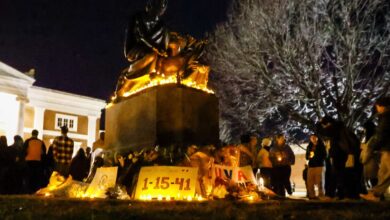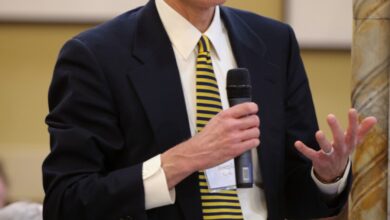The Academic-Freedom Controversy That Won’t Die

Another group joined the conversation on Friday. Hamline administrators, who have previously shared information mostly through written statements, granted an interview to The Chronicle. In it they defended their handling of the controversy, in which Erika López Prater, the lecturer, saw her contract go unrenewed after the course ended.
Many academics and academic-freedom groups have criticized Hamline leaders for their treatment of López Prater, and for statements the institution’s president, Fayneese S. Miller, has made about the need to balance academic freedom with concerns for student safety and well-being. PEN America called it “one of the most egregious violations of academic freedom in recent memory.” Meanwhile, the Minnesota chapter of the Council on American-Islamic Relations has applauded the university.
Hamline administrators told The Chronicle on Friday that what happened in the art-history class, and their view of teaching depictions of the Prophet Muhammad, had been inaccurately reported.
But their comments raised more questions about the series of events that continues to roil the small campus.
“In my syllabus, I did note that I would be showing both representational and nonrepresentational images of holy figures such as the Prophet Muhammad and Jesus Christ and the Buddha,” she said in a recent online panel. “And during my class, I did give my students a heads-up that I was about to show an image of the Prophet Muhammad.”
But Marcela Kostihova, dean of Hamline’s College of Liberal Arts, said on Friday that was not true. “The images were already on screen from the moment that the lecture began,” she said in a video call with The Chronicle.
“Hamline University absolutely supports the teaching of this material,” she said, as Miller, the president, nodded along. There were “many [other] ways” in which López Prater could have taught the painting that Hamline leadership would have found acceptable, Kostihova said.
The Chronicle provided this version of events to David Redden, a lawyer for López Prater, but neither responded in time for publication. Hamline administrators have a student’s recording of the class and cited it to support their claims about López Prater, but declined to provide a copy of it to The Chronicle.
The Oracle, Hamline’s student newspaper, obtained a video of the same class last year, but appeared to differ in reporting what it showed: “The professor gives a content warning and describes the nature of the depictions to be shown and reflects on their controversial nature for more than two minutes before advancing to the slides in question.”
Aram Wedatalla, president of the campus Muslim Students Association and a student in López Prater’s class, objected to the instructor’s use of the painting and complained to her after the class, and later to Hamline leaders. López Prater apologized two days later for causing the student “emotional agitation,” according to The Oracle.
In a recent news conference hosted by the Minnesota chapter of CAIR, Wedatalla said she was still pained by the incident. “It hurts and it breaks my heart to stand here to tell people and to beg people to understand me, to feel what I feel,” she said, through tears.
For López Prater, the connection between the class session and the nonrenewal seemed concrete. In the online panel, she recalled discussing with her department chair in late September a course on contemporary art that she could teach in the spring. “They were very excited to have me back,” she said. Then came the October 6 class, and a change in her chair’s attitude. “By mid- to late October,” she recalled, “my chair told me that my services were no longer needed for the spring. And she expressed this with rather vague wording.”
A Hamline administrator wasn’t quite as vague. On November 7, David Everett, vice president for inclusive excellence, wrote an email to the campus in which he, without referring to López Prater by name, called the incident Islamophobic. The Oracle quoted Everett as saying, “In lieu of this incident, it was decided it was best that this faculty member was no longer part of the Hamline community.”
Miller and other administrators have said plainly that they disagree with how López Prater handled the class. Miller was one signer on an email that said “respect for the observant Muslim students in that classroom should have superseded academic freedom.”
But Hamline’s leaders said on Friday that López Prater had not lost her job as a result of the decision to show a depiction of the Prophet. When asked whether it was true that the incident was unrelated to the nonrenewal, as the administrators appeared to be claiming on Friday, Miller replied, “That’s correct.” She then referenced “other things that were a factor in making the decision not to offer a letter of reappointment for the spring.”
Kostihova, the dean, alleged that after López Prater failed to provide a true warning about the image — a claim that is in dispute — the instructor also didn’t acknowledge that fact, and was insensitive in how she responded to Wedatalla.
After the interview concluded, The Chronicle reached out to Hamline to further specify what factors led to the instructor’s nonrenewal, but that request was not answered by Friday evening.
The Hamline administration may think there are acceptable ways to teach ancient paintings of the Prophet Muhammad, which are historically significant, but it’s unclear whether some members of the Muslim community in the Twin Cities would agree.
During the CAIR chapter’s’s news conference, Jaylani Hussein, its executive director, called the issue of whether López Prater had provided adequate warning “a side conversation.” Given the history of hate groups’ using images of the Prophet Muhammad to insult Muslims, all displays of the Prophet are “intended to communicate hate,” reads a statement on the Minnesota chapter’s website.
The national organization has a different view. On Friday it released a statement in which it said, in part: “Although we strongly discourage showing visual depictions of the Prophet, we recognize that professors who analyze ancient paintings for an academic purpose are not the same as Islamophobes who show such images to cause offense. Based on what we know up to this point, we see no evidence that former Hamline University Adjunct Professor Erika López Prater acted with Islamophobic intent or engaged in conduct that meets our definition of Islamophobia.”
As Hamline continues to make headlines, current and former students and employees worry about the potential lasting effects on how others view the college. “Watching how this incident has unfolded,” said Linda N. Hanson, who preceded Miller as president, “began to give me grave concern about the reputation of the school.”






